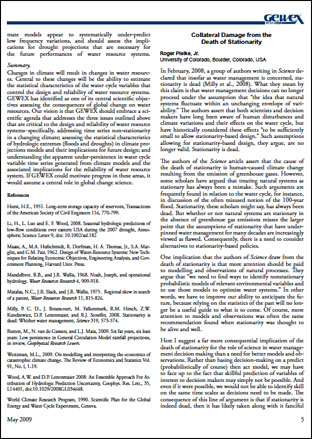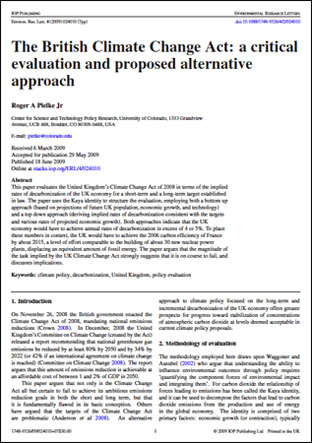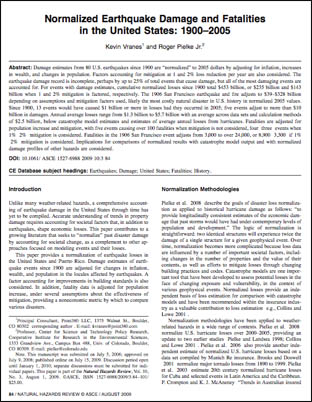Recent Publications
The following represents a sample of the numerous publications authored by Center staff. For a complete, searchable list, with online versions of most articles, visit our Publications page.
Cherney, D., 2009. Kennedy, Sheila S., God and Country: America in Red and Blue. Policy Sciences 42:189–191.
 Excerpt: It requires little imagination to believe that the United States is a polarized nation. Divisive discourses about issues such as abortion, gun control, the definition of marriage, immigration reform, and climate change often leave little room for compromise or finding common ground. In God and Country: America in Red and Blue, Sheila Kennedy of Indiana University’s School of Public and Environmental Affairs argues that the popular religious-secular dichotomy used to understand persistent policy conflicts obscures our ability to recognize the root of political disagreement in this country. In her detailed study of American perspectives, Kennedy outlines an alternative framework that she insists better captures the true nature of American conflict…Read more.
Excerpt: It requires little imagination to believe that the United States is a polarized nation. Divisive discourses about issues such as abortion, gun control, the definition of marriage, immigration reform, and climate change often leave little room for compromise or finding common ground. In God and Country: America in Red and Blue, Sheila Kennedy of Indiana University’s School of Public and Environmental Affairs argues that the popular religious-secular dichotomy used to understand persistent policy conflicts obscures our ability to recognize the root of political disagreement in this country. In her detailed study of American perspectives, Kennedy outlines an alternative framework that she insists better captures the true nature of American conflict…Read more.
Pielke Jr., R.A., 2009. Collateral Damage from the Death of Stationarity. GEWEX, May, pp. 5-7.
 Excerpt: In February, 2008, a group of authors writing in Science declared that insofar as water management is concerned, stationarity is dead (Milly et al., 2008). What they mean by this claim is that water management decisions can no longer proceed under the assumption that “the idea that natural systems fluctuate within an unchanging envelope of variability.” The authors assert that both scientists and decision makers have long been aware of human disturbances and climate variations and their effects on the water cycle, but have historically considered these effects “to be sufficiently small to allow stationarity-based design.” Such assumptions allowing for stationarity-based design, they argue, are no longer valid. Stationarity is dead.
Excerpt: In February, 2008, a group of authors writing in Science declared that insofar as water management is concerned, stationarity is dead (Milly et al., 2008). What they mean by this claim is that water management decisions can no longer proceed under the assumption that “the idea that natural systems fluctuate within an unchanging envelope of variability.” The authors assert that both scientists and decision makers have long been aware of human disturbances and climate variations and their effects on the water cycle, but have historically considered these effects “to be sufficiently small to allow stationarity-based design.” Such assumptions allowing for stationarity-based design, they argue, are no longer valid. Stationarity is dead.
The authors of the Science article assert that the cause of the death of stationarity is human-caused climate change resulting from the emission of greenhouse gases. However, some scholars have argued that treating natural systems as stationary has always been a mistake. Such arguments are frequently found in relation to the water cycle, for instance, in discussion of the often misused notion of the 100-year flood. Stationarity, these scholars might say, has always been dead. But whether or not natural systems are stationary in the absence of greenhouse gas emissions misses the larger point that the assumptions of stationarity that have underpinned water management for many decades are increasingly viewed as flawed. Consequently, there is a need to consider alternatives to stationarity-based policies…Read more.
Prins, G., Cook., M., Green, C., Hulme, M., Korhola, A., Korhola, E.R., Pielke, Jr., R., Rayner, S., Sawa, A., Sarewitz, D., Stehr, N., and H. von Storch, 2009. How to get climate policy back on course. Institute for Science, Innovation and Society, Oxford University and London School of Economics, The Mackinder Programme, LSE.
 Roger Pielke, Jr. co-authored a new report “How to get climate policy back on course.” The authors argue that “Because climate policy performs so many other sorts of political, religious and psychological work, it has tremendous momentum within it. Part of that momentum has been brutally halted by the recession. We should profit from this; and so we argue that we should not only learn the lessons of this surprise. We should switch decisively to a radically different but also very familiar approach to policy which focuses upon actions that have worked in the past and which we know to be politically feasible. This track stands in contrast to current conventional wisdom which, oddly, is grounded upon policies that have not worked in the past and which we know never to have been politically feasible except through the application of unacceptable political forces.” Read more.
Roger Pielke, Jr. co-authored a new report “How to get climate policy back on course.” The authors argue that “Because climate policy performs so many other sorts of political, religious and psychological work, it has tremendous momentum within it. Part of that momentum has been brutally halted by the recession. We should profit from this; and so we argue that we should not only learn the lessons of this surprise. We should switch decisively to a radically different but also very familiar approach to policy which focuses upon actions that have worked in the past and which we know to be politically feasible. This track stands in contrast to current conventional wisdom which, oddly, is grounded upon policies that have not worked in the past and which we know never to have been politically feasible except through the application of unacceptable political forces.” Read more.
Pielke, Jr., R. A., 2009. The British Climate Change Act: A Critical Evaluation and Proposed Alternative Approach, Environmental Research Letters, Vol. 4(2).
 Abstract: This paper evaluates the United Kingdom's Climate Change Act of 2008 in terms of the implied rates of decarbonization of the UK economy for a short-term and a long-term target established in law. The paper uses the Kaya identity to structure the evaluation, employing both a bottom up approach (based on projections of future UK population, economic growth, and technology) and a top down approach (deriving implied rates of decarbonization consistent with the targets and various rates of projected economic growth). Both approaches indicate that the UK economy would have to achieve annual rates of decarbonization in excess of 4 or 5%. To place these numbers in context, the UK would have to achieve the 2006 carbon efficiency of France by about 2015, a level of effort comparable to the building of about 30 new nuclear power plants, displacing an equivalent amount of fossil energy. The paper argues that the magnitude of the task implied by the UK Climate Change Act strongly suggests that it is on course to fail, and discusses implications… Read more.
Abstract: This paper evaluates the United Kingdom's Climate Change Act of 2008 in terms of the implied rates of decarbonization of the UK economy for a short-term and a long-term target established in law. The paper uses the Kaya identity to structure the evaluation, employing both a bottom up approach (based on projections of future UK population, economic growth, and technology) and a top down approach (deriving implied rates of decarbonization consistent with the targets and various rates of projected economic growth). Both approaches indicate that the UK economy would have to achieve annual rates of decarbonization in excess of 4 or 5%. To place these numbers in context, the UK would have to achieve the 2006 carbon efficiency of France by about 2015, a level of effort comparable to the building of about 30 new nuclear power plants, displacing an equivalent amount of fossil energy. The paper argues that the magnitude of the task implied by the UK Climate Change Act strongly suggests that it is on course to fail, and discusses implications… Read more.
Vranes, K., and R. A. Pielke, Jr., 2009. Normalized Earthquake Damage and Fatalities in the United States: 1900 - 2005, Natural Hazards Review, August, pp. 84-101.
 Abstract: Damage estimates from 80 U.S. earthquakes since 1900 are “normalized” to 2005 dollars by adjusting for inflation, increases in wealth, and changes in population. Factors accounting for mitigation at 1 and 2% loss reduction per year are also considered. The earthquake damage record is incomplete, perhaps by up to 25% of total events that cause damage, but all of the most damaging events are accounted for. For events with damage estimates, cumulative normalized losses since 1900 total $453 billion, or $235 billion and $143 billion when 1 and 2% mitigation is factored, respectively. The 1906 San Francisco earthquake and fire adjusts to $39–$328 billion depending on assumptions and mitigation factors used, likely the most costly natural disaster in U.S. history in normalized 2005 values. Since 1900, 13 events would have caused $1 billion or more in losses had they occurred in 2005; five events adjust to more than… Read more.
Abstract: Damage estimates from 80 U.S. earthquakes since 1900 are “normalized” to 2005 dollars by adjusting for inflation, increases in wealth, and changes in population. Factors accounting for mitigation at 1 and 2% loss reduction per year are also considered. The earthquake damage record is incomplete, perhaps by up to 25% of total events that cause damage, but all of the most damaging events are accounted for. For events with damage estimates, cumulative normalized losses since 1900 total $453 billion, or $235 billion and $143 billion when 1 and 2% mitigation is factored, respectively. The 1906 San Francisco earthquake and fire adjusts to $39–$328 billion depending on assumptions and mitigation factors used, likely the most costly natural disaster in U.S. history in normalized 2005 values. Since 1900, 13 events would have caused $1 billion or more in losses had they occurred in 2005; five events adjust to more than… Read more.
For a complete list of Center publications see our Publications page.

